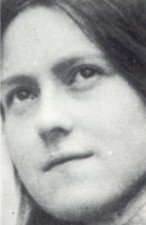
Obviously St. Therese was a prayerful woman. After all she gave herself to a life of prayer and self-emptying love in the Carmel of Lisieux in Normandy. The interesting question centers on how she prayed. She had learned the importance of prayer as a child from the example of her own parents and used to spend some time in the quiet of her room reflecting on the life of Jesus and on God’s love for her.
When she joined the Carmel in Lisieux she had appointed times for community prayer throughout the day. Recitation of the breviary, a daily Eucharist and vocal prayer were part of a nun’s identity in Carmel. But there was also time for personal or private prayer. Each day the nuns spent about an hour in quiet meditation on God’s word. St. Therese reports in her Story of a Soul that she was faithful to community prayer but often enough experienced a certain dryness in prayer. She was more faithful to prayer than moved to “good feelings”.
One way of prayer was especially attractive to St. Therese. She loved to draw close to Scripture and to leam about Jesus Christ from the gospels. In fact, St. Therese wrote that when she was having a particularly arid period in prayer, the gospels always nurtured her. She found that the word of God was “a lamp for her feet” as Scripture says. She would love to retain favourite passages or lines from scripture so that they came back to her during the day and energized her own commitment to Jesus Christ. In fact, St. Therese wrote that often enough a word from God, an insight, a sense of direction, a response to a situation came to her not during the hour of prayer but when she was about her daily work.
St. Therese had devotion to Mary and turned to her in prayer as her mother. In fact, it was during a devastating illness when she was but ten years of age that she experienced a cure through Mary’s intercession. St. Therese saw that the statue of Mary in her bedroom smiled at her. From that moment she no longer experienced the troubles caused by anxiety and perhaps depression.
Prayer for St. Therese was a way of walking with God. Whether it was a period of meditative prayer, communal prayer in the chapel with the other nuns in the community or the aspirative prayer of lifting her heart to God in short prayers of intercession or praise, she realized that God was with her. Her deep trust in God and in God’s love for her paved a way of joy and happiness. Can not each one of us learn something of life’s purpose by observing the faith-filled direction of St. Therese’s life?
John F. Russell, O.Carm.
Seton Hall University
South Orange, N.J. 07079
Sicut Parvuli
January 2000
Vol. LXII No. 1
